|
THE FAIRFORD BRANCH LINE |
|
|
|
BRIZE NORTON & BAMPTON |
|
Brize Norton was an unremarkable Upper Thames Valley village at the time the railway was constructed, now however it is world famous as home to the largest RAF airbase in the
country. Bampton, on the other hand, has seen a reversal of fortunes, having been a town of some importance in the middle ages, its dominance in the area was replaced by Witney, largely due to the latter's better
transport links, and the increasing importance of its blanket industry and mills. During the years the railway was operating both Brize Norton and Bampton were largely agricultural. |
 |
|
Brize Norton & Bampton station, pictured shortly before closure in 1962. All the principal buildings on the site can be seen in this view. The different coloured roof tiles, and the plain gable end of the later parcels extension can be seen at this end of the
building.
Martin Loader Collection
|
 |
With the outline of Lew Hill in the background, 57xx 0-6-0PT 9653 arrives at Brize Norton & Bampton station with the 16:26 Oxford to Fairford train on 16 June 1962, the final day
of passenger services. Originally named Bampton, the construction of nearby RAF Brize Norton just before the Second World War led to the station being renamed Brize Norton & Bampton. The 3¾ miles between Witney and
Bampton stations was the longest distance between stations on the line. Judging by the bright ballast visible in the background, either the trackwork was exceedingly well maintained, or
as often happened when branch lines were due to close, the track was reballasted!
Colour Rail |
|
Originally called Bampton, the station was actually nearer the village of Brize Norton, using the word "near" in the loosest possible sense! In typical East
Gloucestershire Railway style it was remote from any habitation. Nonetheless, it was moderately busy and until the opening of nearby Carterton station in 1944, was the only place on the EGR where two passenger trains
could cross. We have now traveled 11 miles 66 chains from Yarnton Junction and have descended into the flat meadows of the upper Thames Valley. The last piece of high ground was the 350 feet high Lew Hill, which the
railway skirted before dropping down into the station. |
|
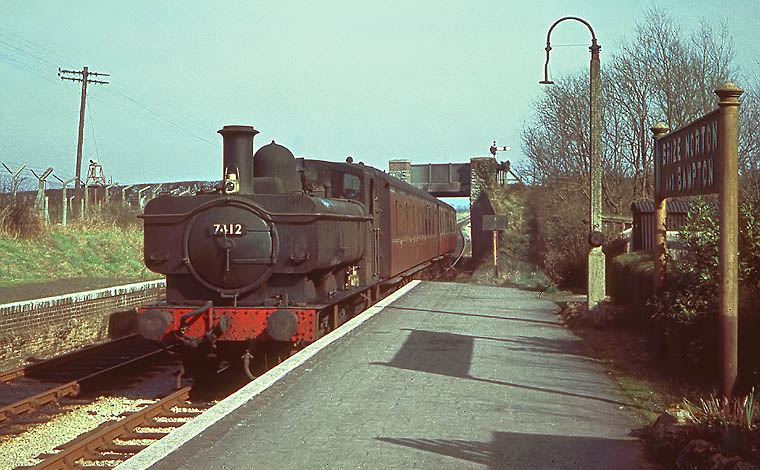
|
|
74xx 0-6-0PT 7412 arrives at Brize Norton & Bampton on 4 March 1961 with the 12:18 Oxford to Fairford service. There is plenty of interesting detail in this view. The standard
narrow EGR road bridge, with the signal just beyond, already has its replacement concrete panel sides, which survive to this day. Other features to note are the trespass warning notice at the end of the platform, the
corrugated iron lamp hut behind the nameboard, and the pulley arrangement for hoisting the lamps up to the top of the concrete lamppost. I am not sure what the silver device on a frame near the pole on the left is, but
as this was inside the airfield perimeter, and this was at the height of the Cold War, I assume it
is a USAF siren for use in the event of a nuclear incident.
Gerald T. Robinson |
|
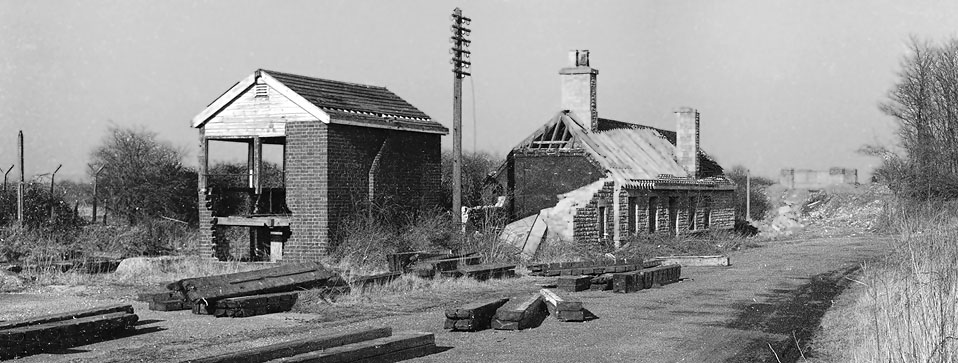
|
|
Situated to the west of the road overbridge (SP306060), the station survived in an almost complete (although progressively more derelict) state longer than most of the EGR
stations. The view above shows the signal box and station building from the approach road side on 5 March 1978. Although the bridge seen in the background still survives, an industrial estate now covers the entire
station site.
Martin Loader |
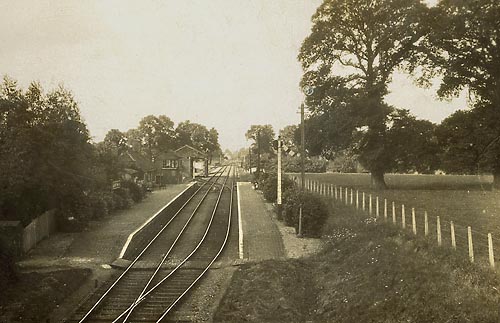 |
An interesting view of Bampton station (as it was known then) from the road bridge sometime prior to the late 1930s. It is immediately obvious that this view pre-dates the
construction of RAF Brize Norton, as the airfield came right up to the railway boundary (see next picture), and the two Elm trees that dominate this view, as well as the hedge in the background
which would have been swept
away around 1937. This picture is reproduced from a postcard that was posted in 1948 - hardly an up to date view at the time!
Martin Loader Collection |
|
Brize Norton & Bampton station, looking south-west towards Carterton shortly before closure. In fact, on the original Kodachrome transparency it is just possible to see the bridge at Carterton,
nearly 1½ miles away! This view clearly shows the layout of the station and the goods yard beyond. Notice the generous width of the platforms, and as usual in pictures of stations on the Fairford Branch, a total
absence of passengers!
Colour Rail |
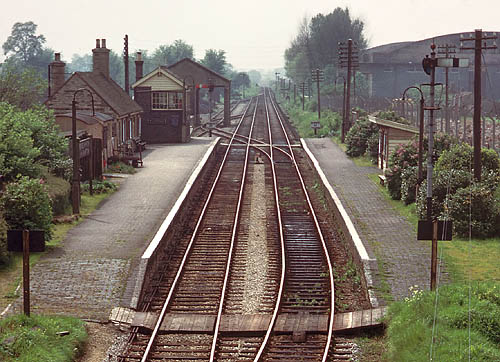
|
|
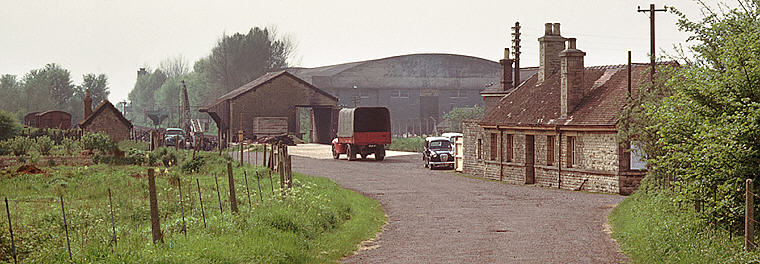
|
|
An early 1960s view of Brize Norton & Bampton station from the approach road, showing how the hangers of RAF Brize Norton came to dominate the scene. The new stonework of the
station building parcels office extension is readily apparent in this view. Notice also the modification to the chimneys, with different coloured tiles indicating the position of the original stack. The tall pipe at the
end of the building nearest the camera was from the parcels office stove. On the extreme left a couple of wagons can be seen in the back siding adjacent to the weighbridge hut.
Colour Rail |
|
A view from the barrow crossing at the west end of the station, looking through the platforms, towards the road bridge. Note the way that the barrow crossing bisects the crossovers, obviously leading to some quite complicated timber work during its construction.
Bob Brown
|
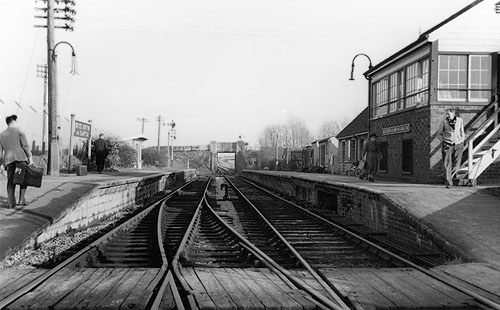 |
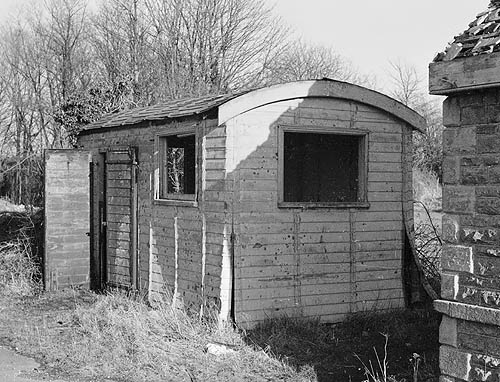 |
The cycle shed at Brize Norton & Bampton looked suspiciously like an old railway van body. It was situated at the east end of the station building, and is seen here on 5 March
1978. Of course, during the heyday of the branch line age, proper storage for cycles was more important than car park provision. As can be seen from the picture above, the car park was really no more than the wide roadway,
and even by the 1960s the only cars would normally belong to either the station master, or some other railway employee or goods agent. However, bicycles were used extensively, and my father remembers this shed often being
full of cycles. Pre-war he used to cycle from Carterton to catch the train here to Oxford to visit the cinema.
Martin Loader |
|
Pictured from the leading coach of the 12:18 Oxford to Fairford train with 57xx 0-6-0PT 9653 in charge, the 12:32 Fairford to Oxford service is seen arriving at Brize Norton & Bampton on 17 April
1959, hauled by 74xx 0-6-0PT 7412. These were two of the most regular locos on the line at
the time. In the late 1950s the only other occasion passenger trains crossed was at Witney in the evening, when the 18:10 Fairford to
Oxford crossed the 18:17 Oxford to Fairford. This picture gives a good view of the small wooden shelter on the up platform, with the ever dominant aircraft
hangar in the background.
Martin Loader Collection |

|
 |
On 4 March 1961, 57xx 0-6-0PT 7760 accelerates away from Brize Norton & Bampton with the 12:32 Fairford to Oxford service. It has just crossed the 12:18 Oxford to Fairford train
hauled by 74xx 0-6-0PT No. 7412, which can just be seen departing in the background. A similar scene to the picture above. Prominent in the background is one of the original
hangars of Brize Norton airfield, at this time
under the command of the USAF. The main runway can just be seen behind the fence on the right of the picture.
Gerald T. Robinson
|
|
Prior to its demolition in the mid 1980s, the station building underwent a partial restoration. A new slate roof has just been fitted in this 5 April 1980 platform side view. The new
parcels office added after World War 1 can be seen at the far end of the building. Note that it has a plain gable end instead of the more elegant (and costly!) half-hipped arrangement seen at this end above the demolished
toilet block. The cycle shed used by my father prior to taking the train to Oxford for visits to the cinema can be seen in the background!
Martin Loader
|
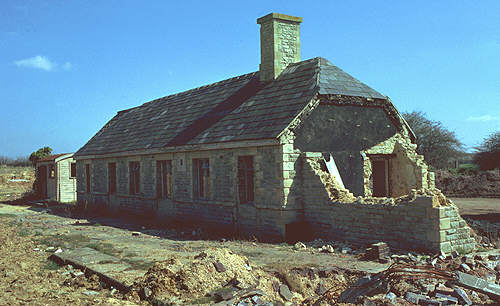
|
|
An interesting piece of World War 2 military equipment could be seen next to the approach road to the station until the mid 1970s. The Alan-Williams steel turret was an ingenious
variation on the standard pill box. The pre-fabricated domed top section had a pair of sliding doors for observation and internally it was equipped for Bren & Lewis guns, and the Boys anti-tank rifle. This was one of
199 such UK defence turrets, very few of which now remain.
|
|
An interesting view of weekend engineering work being carried out at Brize Norton & Bampton station. While the workmen busy themselves with a PW trolley, an engineers train can be
seen under the bridge in the background. The 1 in 100 gradient that commenced at the end of the platforms can quite clearly be seen in this view. This picture not only gives a good view of the up platform shelter, but the
various sheds next to the station building can also be seen.
J. H. Moss (Martin Loader Collection)
|
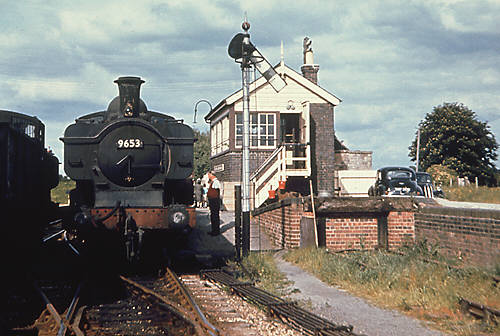 |
In May 1962, 57xx Class 0-6-0PT 9653 calls at Brize Norton & Bampton with the 18:17 Oxford to Fairford train. It is seen here crossing the 18:20 Fairford to Hinksey freight, hauled
by another 57xx pannier tank. 9653 was one of the regular Fairford Branch locos, working trains right up to the last day. It was withdrawn from Oxford depot (81F) in July 1965, and after languishing there for a further two
months, was removed to Birds scrap yard at Long Marston, where it was cut up in October 1965. This picture also gives a fine view of the standard GWR signal box with 19 levers situated on the down platform, also the
down starting signal and end loading bay.
John Strange
|
|
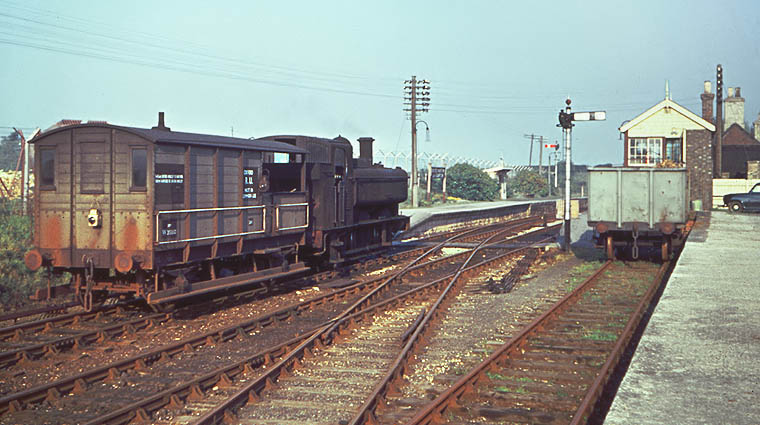
|
|
An interesting scene at Brize Norton & Bampton on 14 October 1961 showing one of the rarely photographed freight workings on the branch. By this date, there was only one regular freight service
that traversed the whole branch, the second terminated at Witney. Here we see 74xx 0-6-0PT 7412 with the 11:15 Fairford to Hinksey service with either no revenue earning traffic, or during a break in shunting. This loco
would have worked down the branch with the 05:45 Hinksey to Fairford, arriving at the terminus at around 08:30. The ex GWR Toad brakevan W35330 was dedicated to this train, and has the two workings mentioned above
painted on the black panel on the end nearest the camera.
Gerald T. Robinson |
|
By March 1978 the signal box had become rather dilapidated, although at least it retained most of its roof tiles unlike the adjacent station building. This box had to liaise with the
adjacent airfield as one of the aircraft taxiways actually crossed the line between here and Carterton.
Martin Loader
|
 |
|
With most of the floor missing
(resulting in a long drop into the former frame room) and the roof
partially collapsed, taking this picture inside the signal box on 20 May 1979 was a little
dangerous! The goods shed can be seen in the distance. Obviously this building was beyond repair but it seems a shame that neither the station building or goods shed (both substantial stone structures) could have been saved
and incorporated into the later development.
Martin Loader
|
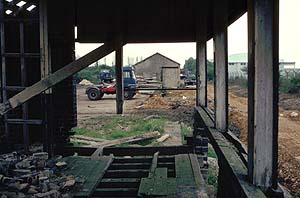 |
|
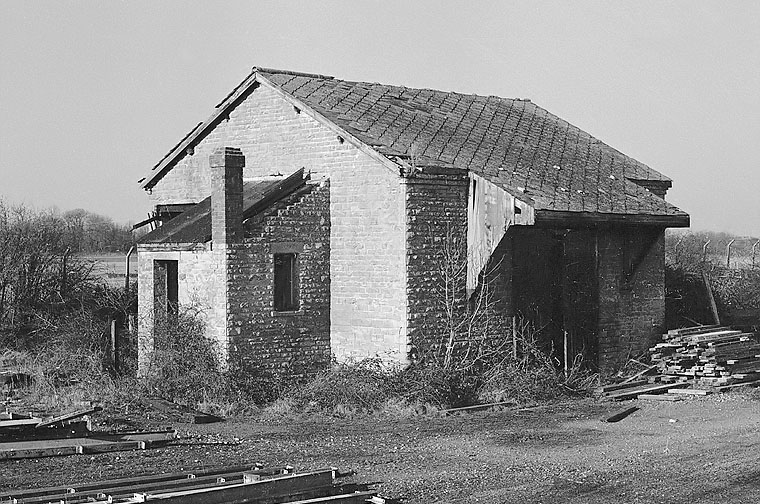
|
|
Brize Norton & Bampton's good shed was the last of the three such East Gloucestershire Railway structures to survive. It is seen here over 15 years after the line closed, on 5
March 1978 in a semi derelict state, but still basically intact and unaltered. This view looking north from the road side clearly shows the lean-to office with its brick chimney contrasting with the local Cotswold stone
used for the remainder of the building. The security fence of RAF Brize Norton can be seen in the background, the line to Alvescot passed between this and the building.
Martin Loader |

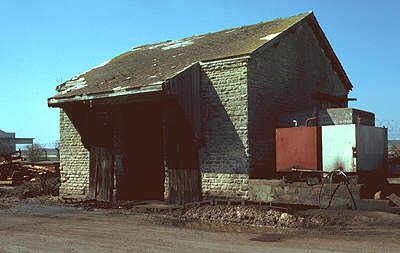
|
These two views taken on 5 April 1980 show the western end (top) and the approach road side (lower). In the top picture the rail entrance had recently being blocked off with breeze
blocks but a single plank of wood from the original door hangs from the one remaining hinge! The lower view shows the double sliding doors for road vehicular access underneath a small canopy. Note also the red tiled roof.
The EGR goods sheds were virtually identical, being approximately 30 feet square and equipped internally with a raised loading area and hand operated crane. By the time these photographs were taken, the station site had been
taken over for industrial use, hence the diesel tanks on the goods loading platform and the junk and rubble surrounding the building. In its final form, the station had a fairly extensive track layout. In addition to the
passenger passing loop, the goods shed was on another loop with headshunts in both directions. A further long siding primarily for coal traffic ran along the south side of the site. A weighbridge was situated near the end of
this siding and there was a small ground frame at the Carterton end of the goods loop.
Martin Loader
|
|
From Brize Norton & Bampton the line continued in a dead straight line towards the next station - Carterton, crossing two aircraft taxiways (SP297055 & SP295054). Please do not
even try to investigate these, as they still lie within the confines of RAF Brize Norton, which is a major military installation with consequent stringent security. In later years the portion of the base on the far side of the
line was extended, and being sufficiently far away from the main buildings was used as a centre for fire practice, consequently, many pensioned off military aircraft met their end there!
|
|
Could this possibly be the last remaining section of Fairford Branch track still in situ? In June 2005 track remains could still be seen on the site of the taxiway crossing (SP297055)
within the confines of RAF Brize Norton. This view is looking west towards the site of Carterton, some ½ mile distant. Other sections of track that survived being lifted along with the rest of the line included the
sections of rail inside both Eynsham and Witney goods sheds, and a short section near the stationmaster's house at Witney.
P.J.D. |

|
|